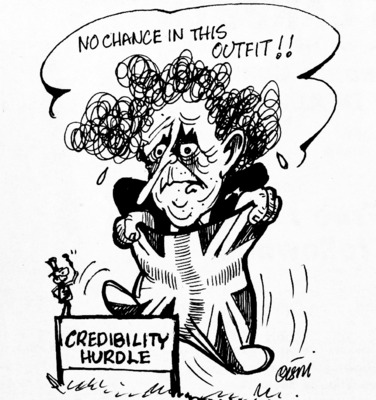WE look at the stories that were making the headlines this week in the Andersonstown News in 1982
1981 Census cover-up
Glenpark Social Club guests Eddie Gallagher, Tommy Blake, Peter Magill and Paddy Cassidy at the opening of the new Kennedy Room in the Shamrock Club
FOLLOWING approaches by a number of individuals at present compiling population statistics in Belfast, the Andersonstown News has uncovered what appears to be a deliberate plot by the Northern Ireland Office to conceal the true facts revealed by the 1981 Census.
The British, the 26 County and the Six County census surveys were all carried out at about the same time. The British results are out; the 26 County results are out, but the Northern Ireland Office has not yet authorised the release of the Six County figures.
Information at our disposal indicates that the frantic cover-up operation is an attempt to conceal four key facts. These facts are considered to be political dynamite since they are bound to frustrate British policy.
Fact One: There has been a massive decline in the total population of the Six County area. This decline is due to wholesale emigration of sections of the Protestant population. The emigrants have mainly headed for Scotland, Canada and South Africa.
Fact Two: Despite the pressures of the last ten years, the Catholic population in the Six Counties has grown substantially.
Fact Three: The ratio of Protestants to Catholics has now decisively and permanently altered. Projections indicate that within ten years, Catholics will form a majority of the population. Since most of the Catholic population falls within the younger age groups, additional time must elapse before Catholics form majority of voters. Nevertheless, the days of Unionist dominance are numbered.
Fact Four: The Census figures now conclusively prove the fallacy of the claim that there are "A million Protest- ants" in the Six Counties. The true figure is somewhat less than eight hundred thousands.
When the preliminary results were prepared, senior administrators declared that they were totally un- acceptable. It is known that re-calculations were ordered and that the data was re-run several times on the government computers.
So far, the civil servants have not succeeded in presenting a set of figures which will satisfy their political masters and bluff the public. A "closed door" policy is in operation and members of the public are being refused access to preliminary information already known to be available.
This "zero co-operation" policy has angered academics and researchers who are anxious to compare the Six County results with the situation in the 26 Counties, where the population has grown by four hundred thousand. Nevertheless, civil servants remain tight lipped as the re calculations continue.
Organisers and helpers Pat McConnell, Breige McCarthy, Kathleen Kerr, Eilish Kelly and Teresa Cousins at the Dwyers Club Mixed Pairs Darts Competition
100 new houses for Turf Lodge
PREPARATORY work on a site for 100 new houses between the Monagh by-pass and Downfine estate will be finished by the end of February.
Work will begin then on the first of three phases of building. It is hoped that the initial batch of houses will be handed over to tenants by February 1983 and the estate completed by that autumn.
The high standard dwellings. which vary from four-bedroomed house to bungalows will be set in groups around a paved area much like Poleglass, and there will be two landscaped areas on the estate's boundaries. During construction the site will be fenced off to combat vandals. A 'Lochrin' (metal) fence will divide the finished estate from the nearby privately owned houses of Gransha Park.
Residents of Turf Lodge have complained about the muck strewn on the Monagh Road which is now a dead end, during the excavation. and of the lack of lighting on the road. These difficulties will be eased somewhat during construction, however. Access It is planned to move the path from the by-pass to the Monagh Road up about 30 yards and to build a new lighted pedestrian access.
The amount of rubble and clay on the Monagh Road will also be minimal once the building of the houses commences as there will be no need for lorries or excavating vehicles to continually criss-cross the Monagh Road in the way that they are now.
Some families from the condemned Turf Lodge T-Blocks will be rehoused in this new estate. 108 of the T-Blocks maisonettes have now been demolished. This leaves 152 still standing, but only 82 of these are occupied. The first phase of two storey houses to replace the T Blocks is now under construction.
Tommy Kelly and Bill McKenna (Bass Ireland) at the opening of the new Kennedy Room in the Shamrock Club, Ardoyne
Editorial: Indebted to Silent Too Long
WE are all indebted to the Silent Too Long organisation for reminding us in their recently published book, of the suffering inflicted on hundreds of innocent Catholic families by the defenders of the union with Britain.
Even a quick perusal of this book bears out the fact that British Ulster's defence forces, both legal and illegal, regard the whole Catholic population as legitimate targets in their war against the IRA and other republican groups. How else can one explain away the fact that only 98 republican activists have been killed by these forces, while they have claimed the lives of more than 700 innocent Catholics.
That this should have happened without a massive outcry from the Roman Catholic Church, or without any significant retaliation from the Catholic population in general, shows two things: First of all, that the Roman Catholic hierarchy and a significant proportion of the clergy, still adhere to the old teaching that it is only through suffering that one can hope for salvation, and therefore, the suffering endured by the murder victims’ families was really for their own good. And secondly, the lack of retaliation by the Catholic community shows a remarkable sense of Christian forgiveness unparalleled in recent history. We feel that if casualties on the same scale had been inflicted on innocent civilians in any other country in the world, the out-cry from the Roman Catholic Church would have been tremendous, and rightly so, as is happening in El Salvador at the moment, and which is receiving the vociferous attention of a number of Irish bishops who never once opened their mouths on the "Northern" question.
Quite a number of Catholics feel betrayed by the hierarchy, because of their lack of response to the murder campaign on their community, and especially so when one considers the massive publicity campaign at present being waged on the Catholic school issue which shows what they are capable of when sufficiently aroused about an issue.
The Silent Too Long book states that it only scratches the surface of this horrific subject, but it is nevertheless welcome as a first step in highlighting what is really happening here. (Don't let's forget that 27 innocent victims were killed in 1981) and make us more aware of who the innocent victims really are.
Eamon, PJ, Gerry, Harry, Desi, ‘Docky’, Paul and ‘Daylight’ at the opening of the new Kennedy Room in the Shamrock Club






